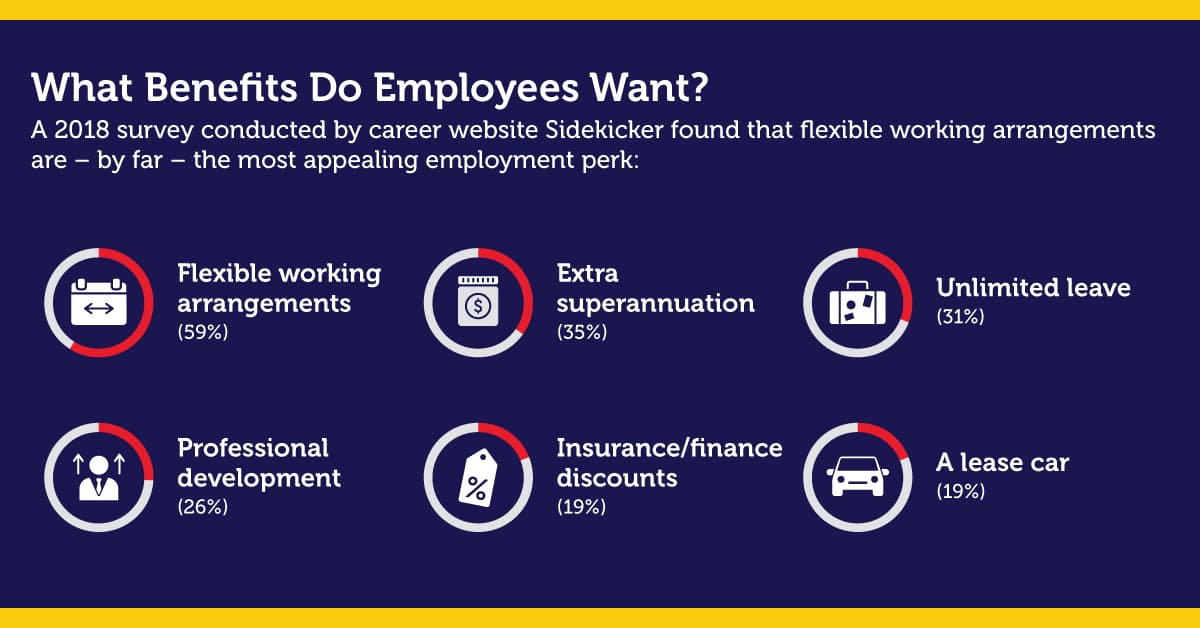Innovative employee benefits, reward and recognition systems: when compensation isn't enough

From flexible working arrangements, free lunch, gym membership, onsite childcare and even rock climbing walls, today’s employee benefits programs in Australia go well beyond a bowl of fruit in the breakroom. Employee benefits have become an essential part of any human resources strategy, especially since the COVID-19 pandemic heralded the “Great Resignation” (where millions of Australians are resigning from their roles).
The modern employee now expects not just great pay and a great culture, but also the many opportunities afforded by comprehensive employee benefits programs. This is part of a broader shift in the delivery of HR strategies and employee expectations.
Businesses of all sizes now need to use employee benefits, often alongside employee rewards and recognition programs, to retain and attract talent and foster a culture of inclusion and diversity.
Employee benefits vs employee entitlements
Today’s employers are offering wide-ranging and increasingly progressive types of employee benefits programs, and many organisations are rewriting policies to ensure that staff is well looked after, both in the workplace and at home. In Australia, employee benefits programs are always in addition to the standard employee entitlements required by Australian law.
Employee entitlements in Australia
Australian employers are obliged by law to ensure that their employees receive the 10 entitlements outlined in the National Employment Standards (NES) under the Fair Work Act 2009, including annual leave, parental leave, long service leave and the right to request flexible working arrangements. In addition to the NES entitlements, which cover all full- and part-time employees and provide partial coverage for casual employees, every person employed in Australia is entitled to the national minimum wage.
Employment contracts, enterprise agreements and awards agreed on by the employer and employee must provide conditions that are equal to (or more than) the NES and national minimum wage. These minimum standards ensure a basic level of employee rights, and failure to comply with them can lead to serious consequences.
Salary and awards
Obvious as it may be, employers must pay employees for the work that they do – whether they're full- or part-time employees or contracted on a casual basis. Along with the national minimum wage that an employee receives, the NES also restricts the number of hours that an individual can work each week. For a full-time employee, the maximum is 38 hours, although some contracts include stipulations allowing employers to request “reasonable overtime” beyond that.
The employee and employer must agree to a salary that complies with the Fair Work Act 2009, which is enforced by the Fair Work Commission. This body is also responsible for setting awards, which are legal agreements that establish the minimum terms and conditions of employment. Awards differ by industry and occupation.
Superannuation
Superannuation is the money diverted from an employee’s salary or wages into a retirement fund that can be accessed after the individual has reached a certain age. At the time of writing, an Australian employer must contribute an amount equal to 10.5 per cent of an employee’s salary to a super fund of the employee’s choice (this amount is in addition to salary or wages).
Additional super contributions
It’s not uncommon for big companies to offer greater contributions as an additional employee benefit and hiring incentive. Individuals can also make voluntary contributions, such as through salary sacrificing arranged by their employers.
Paid super during maternity leave
Based on data from June 2019 median super balances, women between the ages of 60-64 retire with 23 per cent less superannuation than men do, and the most significant factor affecting this gender gap is motherhood. Under the Australian government legislation, employers aren’t required to continue paying an employee’s superannuation while they’re on maternity leave, although some employers voluntarily do so. A 2020-21 survey indicated that up to 81 per cent of employers who are part of the Workplace Gender Equality Agency (WGEA) paid super to those on maternity leave.
Annual and sick leave
Whether employed full-time or part-time, employees inevitably want to take leave at some point, whether for a holiday or for personal illness or injury – and employees are entitled to do so.
Paid annual leave
The amount of paid annual leave that Australian employees receive often depends on their agreements with their employers. However, workers must get at least four weeks of leave in a year, which is calculated based on the number of hours they normally work in a week. A full-time employee who works 38 hours per week, for example, receives 152 hours of paid leave per year. A part-time employee working 15 hours per week receives 60 hours annually (the equivalent of four weeks on their typical work schedule).
Other types of entitlements, like sick leave and carer’s leave, allow employees to take paid time off due to personal illness or injury or for carer responsibilities and family emergencies. The amount of leave depends on how long they’ve worked for their employer and how many hours worked per week. A full-time employee, for example, is entitled to 10 days of sick leave each year. Employers are entitled to ask for proof of illness or injury, such as a medical certificate.
In regard to annual leave and sick leave, casual employees aren’t eligible for the same employee benefits in Australia as full- and part-time staff.
Family and domestic violence leave
Amendments made to the Fair Work Act in 2018 added a new NES entitlement providing unpaid family and domestic violence leave of up to five days each year. Family and domestic violence leave is available to full- and part-time employees as well as casual staff.
Parental leave
Employees are entitled to parental leave when a child is born or adopted. Parental leave includes maternity leave, paternity and partner leave and adoption leave. Through the Australian Government’s Parental Leave Pay scheme, eligible primary caregivers of an infant or adopted child receive 18 weeks of paid leave at the national minimum wage.
In addition to this, employees are entitled to take 12 months of unpaid paternity leave and retain the right to return to their jobs. Employers can offer their own paid parental leave benefits in addition to that provided by the Australian Government. Companies with progressive parental leave policies sometimes also offer paid parental leave to the parents of a stillborn infant.
Long service leave
When an employee has worked for their employer for an ample period of time, they’re entitled to long service leave (LSL): an extended amount of paid leave generally provided in addition to paid annual leave entitlements. State laws regulate both how long an employee must be employed before they’re entitled to LSL and how much time they’re entitled to receive. In Victoria, for example, the Long Service Leave Act 2018 allows employees to apply for LSL after seven years of service.
What benefits do employees want?
Besides the minimum benefits in Australia ensured by the NES and national minimum wage, many employers offer additional employee benefits – both to encourage employee loyalty and to attract new talent.

Employee benefits programs in Australia
The types of employee benefits programs in Australian and international workplaces are diverse, ranging from workplace setups that resemble urban playgrounds to inclusivity and diversity initiatives.
Flexible working arrangements
Flexible working arrangements are fast becoming the new normal and are one of the greatest employee benefits an employer can offer. Flexible working arrangements might include working remotely (e.g. from home), adjusted working hours (e.g. starting later to fit in school drop-offs) and job sharing and splitting shifts.
Employees – including parents, caregivers, people with disabilities and people experiencing domestic or family violence – are entitled by law to request flexible working arrangements. These requests can be denied only on reasonable business grounds.
The value of flexible working arrangements
When it comes to retaining and attracting talent, employee benefits are likely to become even more important. By 2025, around 75 per cent of the global workforce will comprise millennials, who, along with Generation Z, place great importance on having the option of flexible working arrangements.
Because of the pandemic, workplace flexibility isn’t so much a trend as an expectation. Sixty-seven per cent of Australians now work from home compared with 42 per cent before the pandemic. Workplace flexibility lessens geographic limitations, helps save transportation costs and offers benefits for caretakers and those with other commitments.
A comfortable workplace environment
There are innumerable ways in which a workplace environment and experience can be improved for employee wellbeing. Coffee machines and wellness programs (e.g. lunchtime yoga, meditation rooms and gym memberships) are just the beginning.
In addition to facilitating a positive workplace experience, employers are starting to show that they care about their employees’ wellbeing outside the office – often in unique ways. An employee who has just gotten a new pet might receive “pawternity leave”, for example, or staff might receive “doona days” – no-questions-asked extra days off each year – in addition to standard leave entitlements. Another example is menstrual leave, which is increasingly being adopted by Australian businesses to support and normalise women experiencing menstruation issues.
Extra leave entitlements
It may be hard to believe that some employers offer their employees unlimited leave. Beyond mental health days or the perks of an extra day off for one’s birthday, some companies now leave it up to their staff to decide how many days they take off each year.
Progressive employee benefits
Australian employee benefits programs are increasingly progressive, particularly in big companies. In 2018, Westpac introduced new policies that benefit transgender and Indigenous Australians.
Gender transition leave
Westpac staff who are undergoing a sex or gender change are entitled to four weeks of paid transitional leave and up to a year of unpaid leave. In addition to this, Westpac has made counselling and support services available to them. Other major Australian organisations that offer this leave include CSIRO.
Sorry business leave
“Sorry business” is a term used by Indigenous and Torres Strait Islander people to refer to the time of mourning after a death has occurred in the community.
Westpac has introduced a policy that allows Indigenous or Torres Strait Islander employees three days of leave following the death of a family member or other personal tragedy. This is to allow for community ceremonies and other important cultural practices during times of bereavement.
Australia’s most attractive employers
Australia’s top employers typically offer extensive employee benefits and comprehensive employee benefits programs. Australia’s top employer in LinkedIn’s 2022 Top Companies list is the Commonwealth Bank of Australia, or CommBank, which offers flexible working, onsite childcare services and domestic and family violence support.
LinkedIn reports that the very best employers are putting employees in the “driver’s seat” of their own career experiences, offering them everything from greater opportunities to get promoted and gain new skills to increasing flexibility.
According to LinkedIn’s 2022 Top Companies list, Australia’s top 10 most attractive employers are:
- Commonwealth Bank
- Woolworths Group
- NAB
- Westpac Group
- ANZ
- Telstra
- WPP
- Salesforce
- DXC Technology
- Alphabet
Types of employee rewards and recognition programs
Employee rewards and recognition programs are yet another way that employers can demonstrate that they value employee contributions to the success and culture of the business. Recognising achievements (e.g. when a team or an individual finishes an important project) and milestones (e.g. when an employee celebrates a work anniversary) improves workplace culture and employee satisfaction, whether that be through financial rewards, more personalised, on-the-spot feedback or peer-to-peer reviews.
Employee rewards and recognition programs are increasingly digital, using social platforms, employee portals and digital gifts. In Australia, employee benefits programs, or even a single employee benefit, can be the difference between retaining a staff member and having them look for opportunities elsewhere. Digital gifts on offer can range from everything from a car wash voucher to a chance to have an honest conversation with senior people within the business.
What does a successful employee rewards program look like?
In 2021, the Australian HR Awards awarded Youi, a specialist insurer, an award for the best employee rewards and recognition (R&R) program. Youi’s key initiative included a “YourGame” platform, which acted as a central lobby for inclusive and diverse initiatives. This platform increased staff engagement in proactive learning, health and wellbeing programs, ideas contribution and peer-to-peer recognition.
The platform, according to the judges, was the “gold standard” for in-house recognition.
Strengthening company culture through benefits and rewards
Employee benefits, rewards and entitlements are somewhat dependent on a company’s capacity, as well as the nature of the business. After all, not all employers can afford to offer benefits such as onsite childcare as CommBank does. But whether it’s leave benefits, health and wellbeing programs, additional superannuation, non-financial rewards, long-term incentives or flexible working arrangements, employees today expect benefits and rewards beyond their base pay. And employers who are unable to meet these expectations may increasingly face retention and hiring challenges.
Pursue a career in HR management
If you’re interested in designing and implementing innovative employee benefits and rewards systems, a career in human resources leadership may be a good fit for you. RMIT Online’s Master of Human Resource Management program teaches skills that can prepare you to build strong employee teams, develop managerial expertise and improve workplaces.
Learn more about RMIT Online’s Master of Human Resource Management program today and take the next step towards a fulfilling career as an HR leader.
Recommended Readings
What skills do I need to be an HR Manager?
How workplace transformation can expand your HR career options
Which online HR graduate program is right for me – HR or workforce transformation?





